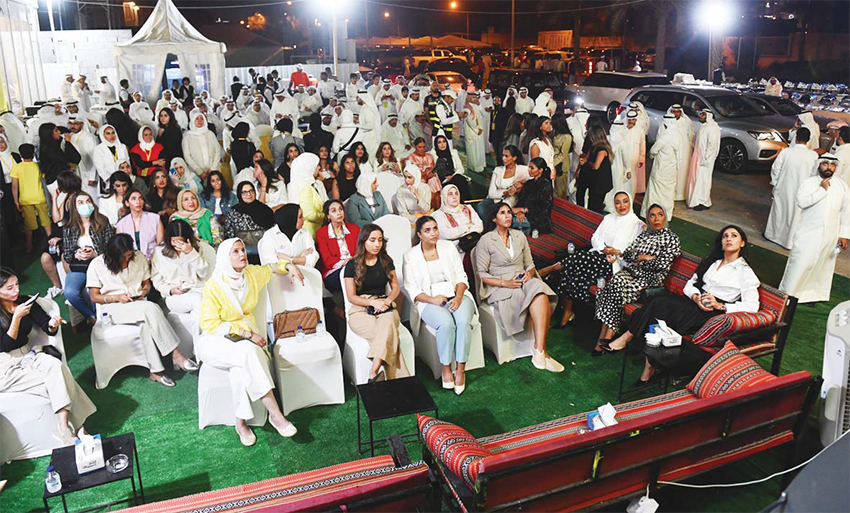24/09/2022
24/09/2022
Printed election advertisements on decline in Kuwait
KUWAIT CITY, Sept 24: Picking up the right colors for any advertisement means the difference between scaring off customers and or bringing them to your shop, restaurant, or even election campaign. In Kuwait’s 2022 National Assembly elections, parliamentary hopefuls are choosing the designs and slogans of their campaigns, but they focused their attention on picking the most eye-catching formation to say they are here and willing to serve the people. In an interview with Kuwait News Agency (KUNA), art criticism professor Dr. Reham Al-Rughaib said that roads in Kuwait and various media platforms were invaded with elections campaigns using an assortment of colors with varying degrees of so-called attractiveness.

Some candidates use certain colors to display their political and ideological alignments, she said, revealing that she noticed that blue was mostly used by male candidates to evoke feelings of calmness and tranquility. If a candidate uses the color red, it mostly emits feelings of courage and confrontation, which some like about Members of Parliament, Dr. Al-Rugaib affirmed. Orange says that the person tries to be creative, yellow refl ects happiness, grey represents an unbiased outlook, white is refl ected on dishdasha (traditional dress worn by men) most candidates wear, and black is usually used for fonts, she said. On her part, psychological consultant and color therapist Suhair Al-Mufidi indicated that colors played an integral role in attracting votes due to their scientific and psychological impact in human beings. People usually pick warm colors such as orange, red, and yellow to attract attention, while cold colors were used to emit calmness and peace, Al-Mufidi added.
Combination
Those using a combination of black and gold in their campaigns want to say they live being authoritative and prestige in the case of black and silver, the candidates displayed authoritative tendencies and social nature, she added. Also chipping in, Kuwait University (KU) professor of psychology Dr. Saleh Al-Saeedi said that choosing the right color was important to display where the candidates came from and what they were willing to do to reach parliament. Dr. Al-Saeedi said that the color orange for example was used mostly to display affiliation to certain groups or blocs, adding that some candidates would choose colors to calm people and try to bring trust in their abilities.
On the commercial aspect, advertisement company partner Abdullah Al-Fadhli indicated that most candidates in this year’s elections preferred to choose the colors of the Kuwaiti fl ag in their advertisements. Blue was the most popular color, while red and orange have an equal presence on various billboards and social media advertisements, he added. Al-Fahdli’s colleague in the same company and head of marketing Abbas Mandani noticed that most candidates did not veer off when using colors for their campaigns. Mandani that far beyond choosing what color to use in advertisement, there is an overwhelming sense of change on the horizon when it came to this election.
Meanwhile, printed election advertisements seemed to be on the decline especially during the current campaign for the 2022 National Assembly elections in Kuwait on September 29. One cannot seem to escape election advertisements with pictures, videos of candidates fl ooding various social media platforms on cellphones and computers. This apparent declined in printed media was not born recently, it coincided with the huge leap in technology witnessed in our modern era. Speaking to KUNA on the issue, editor-in-chief of Al-Anbaa news daily, Mohammad Al-Husseini said that the election campaigns in recent years saw a decline advertisement using the printed medium, noting that around 85 percent of adverts in newspapers nowadays veer towards touting social media platforms.
Targets
Printed media usually targets petitioners, heads of corporations, and probably government employees, added Al-Husseini. The high cost of advertising in printed media seems to be also a culprit in the decline, he affirmed. In the meantime, Abdullah Al-Ulaiyan -- publisher of the online Al-Nukhba news -- said that printed media did not completely disappear from the scene, revealing that a huge swathe of the public still read printed papers. Some preferred to read the daily newspaper via the PDF format, noted Al-Ulaiyan, adding that papers nowadays are also venturing into platforms such as YouTube, WhatsApp and others to spread their content to the masses. He indicated that the whole notion of killing the printed media was far-fetched, affirming that the digital media could not cancel its printed counterpart and vice versa.
Traditional media like radio, television, and newspapers could extend their reach and have a digital arm to continue their relevance in this day and age, Al-Ulaiyan added. On his part, media professor at Kuwait University (KU) Dr. Mohammad Al-Otaibi said that the retreat in elections advertisement in printed media was not something recent, the advent and proliferation of social media had played a crucial role in this aspect. Social media and digital platform has a wide and far reach, bringing thousands if not millions of audiences, he noted, indicating that candidates in this elections had paid attention to the power of digital outlets to attract voters and convince them to give them their vote. Despite the far-reaching hand of digital media platforms, Kuwaitis still prefer to fl ock to candidates’ headquarters to see what they have to offer during the 2022 National Assembly elections. Eligible voters seem to be fixated on the notion they have to see candidates in person before deciding on casting their ballot on September 29. (Report by Sahad Kamal, Nasser Al-Otaibi and Nasser Al-Shalabi - KUNA)


